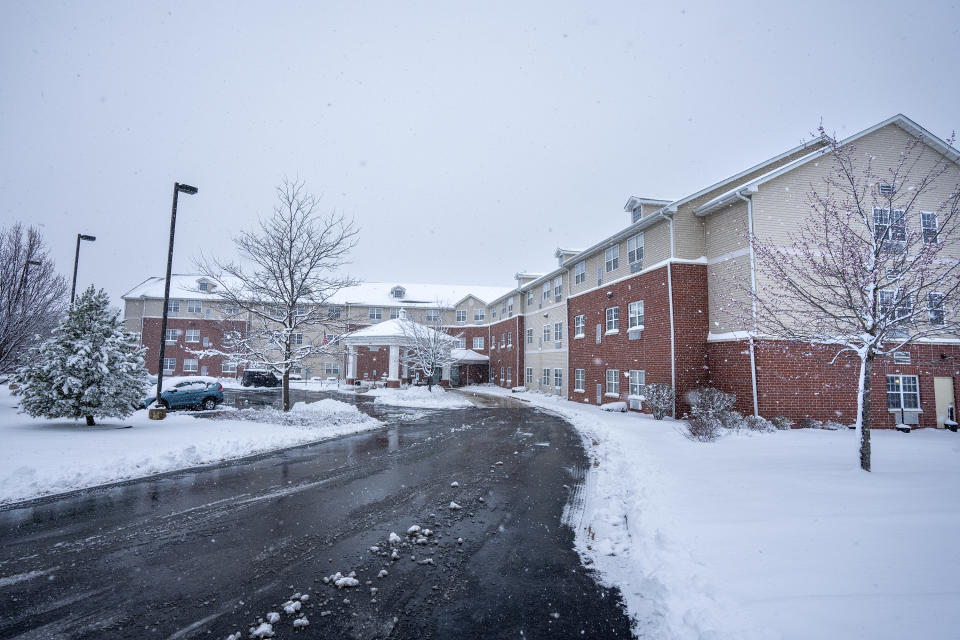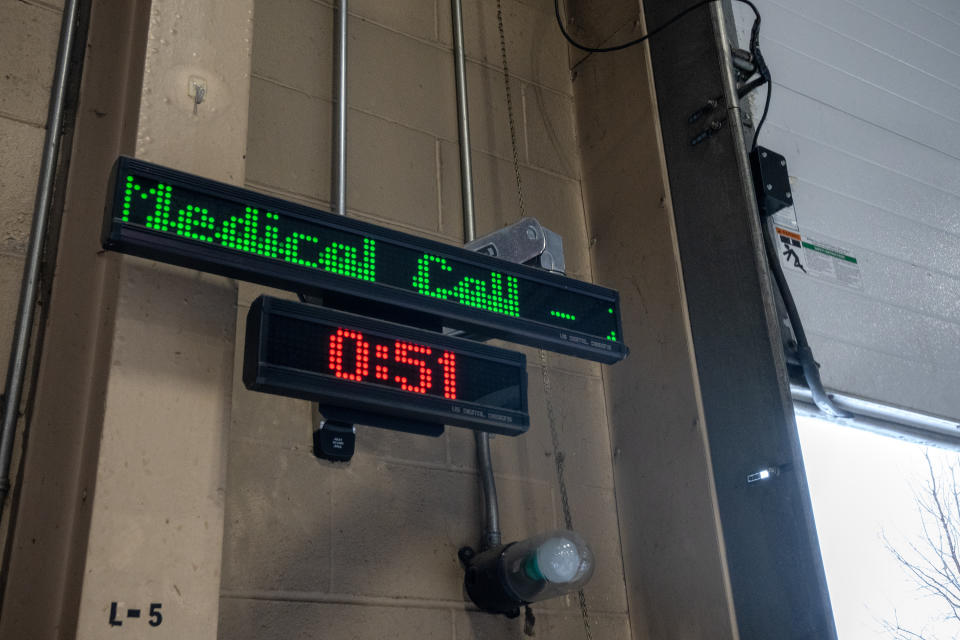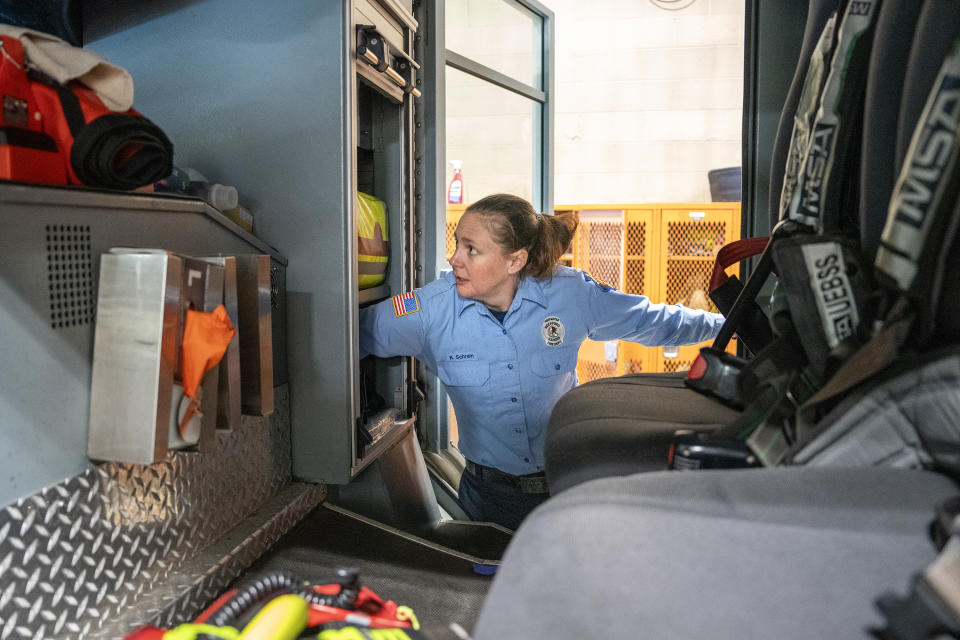Senior homes refuse to pick up fallen residents, dial 911. ‘Why are they calling us?’
ROCKFORD, Ill. - The 911 call came just before 8 a.m., and Ladder 5’s four-man crew scrambled to the truck just as their overnight shift was about to end. It was the kind of call that veteran firefighter Chad Callison said he dreaded.
It was not a heart attack, or a car crash or a building fire.
It was a “lift assist” at Heritage Woods, a local assisted-living facility.
Lift-assist 911 calls from assisted living and other senior homes have spiked by 30 percent nationwide in recent years to nearly 42,000 calls a year, an analysis of fire department emergency call data by The Washington Post has found. That’s nearly three times faster than the increase in overall 911 call volume during the same 2019-2022 period, the data shows.
The growth has infuriated first responders who say these kinds of calls - which involve someone who has fallen and is not injured but can’t get up - unfairly burden taxpayers and occupy firefighters with nonemergencies that should be handled by staff at facilities that charge residents as much as $7,000 a month.
Illinois is a hot spot for the controversy: Lift assists here accounted for 1 in 20 of all 911 fire calls, the highest proportion of any state, the data shows. In Rockford, a city of 150,000 residents about an hour outside Chicago, five assisted-living facilities - including Heritage Woods - called for noninjury lift assists 233 times last year, triple the number of calls in 2021.
When firefighters arrived at Heritage Woods that morning, caretakers at the facility directed them to an elderly resident lying on the floor. She was perfectly fine, she said, she just couldn’t get back on her feet by herself. The facility’s staff wouldn’t lift her. So two firefighters helped her up and made sure she was okay, Callison recalled and fire records show. Ten minutes after arriving on the scene, Ladder 5 was back in service.
“It doesn’t make sense,” Callison said. “Why are they calling us?”
The answer, according to industry critics and fire officials, is that companies want to avoid the risk and expense associated with picking someone up off the floor. Like many cities, Rockford provides lift assists free.
Some senior-care homes say they don’t have the ability to lift fallen residents. Many have adopted “no lift” policies to avoid the risk of back injuries for staff and other potential liabilities. But firefighters and other experts say there are tools to make lifting easier and safer, ranging from $70 cloth straps with handles to $1,500 hydraulic lifts.
Heritage Woods, which accounted for the highest number of lift-assist calls to 911 in Rockford last year, is owned by Gardant Management Solutions, the 10th largest assisted-living provider in the nation.
Co-president Julie Simpkins declined to answer specific questions, but said in a statement that the company works “to create a collaborative approach to the over utilization of nonemergent lift assist calls” through “cross training, resource availability discussions and collaboration.”
A nurse who worked at an assisted-living facility in Greensboro, N.C., who requested anonymity because she was not authorized to speak with the media, said her company required caretakers to call 911 even if a resident had just slid harmlessly out of a chair.
“If you’re on the floor, period, you’d have to call,” said the nurse, who left her position last year. She said residents were often embarrassed by the lift-assist calls. Some begged her not to dial 911. She said she had no choice.
Fire officials point out they bring no special skill to such situations - it’s just a matter of who’s doing the work.
The dispute over lift assists comes as improvements in fire safety and the nation’s aging population have changed the nature of a firefighter’s job. Today, fire and EMS agencies are more likely to deal with an older adult fall victim than a fire victim.
Lift assists are now the seventh most common type of 911 call, with an average of 1,800 lift-assist calls every day nationwide, according to an analysis of the National Fire Incident Reporting System, which collects emergency calls from more than 23,000 fire departments. The data does not include calls to about 13,700 EMS agencies, although there is significant overlap in calls between the two databases.
The calls come often from elderly people living both at home and at facilities. While both situations strain resources, fire officials said senior-care homes should be equipped to handle these calls.
“You go in there, and they have staff all over the place,” said Kevin Joles, an EMS division chief in Lawrence, Kan. “It’s part of our job that’s being taken advantage of, and we’ve mostly stayed quiet about it.”
A growing number of cities and towns - from Rocklin, Calif., to Naples, Fla., to Lincoln, Neb. - have started pushing back with special fees of $100 to $800 for senior lift-assist calls. Most of the fees are targeted at what fire officials call “the frequent fliers” - assisted-living and senior-care facilities.
In Anchorage, the fire department introduced a lift-assist fee to “prevent assisted-living facilities from understaffing, or having inadequate resources, for people under their care,” Josef Rutz, fire department administrator, said in an email. The first lift is free, but a facility’s second lift assist within 12 months costs $250.
Kansas City, Mo., added a lift-assist fee to discourage “repeat offenders,” said Battalion Chief Michael Hopkins. The amount is flexible and set to be “reasonably calculated to defray the costs,” according to city code. The department also contacts facilities to tell them they “need to hire some orderlies,” he said.
In Mequon, Wis., the fee is billed directly to the facility to emphasize that it’s the company’s responsibility, said Deputy Fire Chief Kurt Zellmann.
“We tell them they can’t pass that onto the patient,” he said. But they can’t prohibit it.
Industry groups have largely opposed being singled out.
“Why should assistance to a resident in a care facility - which is their home! - be held to a different standard?” Matt Hartman, president of the Illinois Health Care Association and Illinois Center for Assisted Living, said in a statement to The Post.
In a letter opposing one town’s proposed lift-assist fee, the American Seniors Housing Association, which represents all levels of senior-care communities, called it “a fee-for-service charge for emergency service calls to residential care facilities for seniors.” The association dismissed the unidentified town’s proposal as “illogical” and “illegal.”
The association’s letter also noted that “the fee ultimately will be paid for by the residents” - indicating it will pass on the cost. When contacted by The Post, the senior housing association and other industry groups declined to discuss whether residents are being charged the lift-assist fees.
After Portland, Ore., imposed fees for what it said were unnecessary 911 calls, the Oregon Health Care Association pushed through a state bill in 2021 that makes it harder for local governments to follow suit. The association is politically powerful; Oregon is seen as the birthplace of assisted living.
Assisted-living facilities, which serve more than 1 million residents nationwide, are not as tightly regulated by the federal government as nursing homes, which serve about 1.2 million people, according to industry estimates. The growth in assisted living has led to new problems: A Post investigation last year revealed that more than 2,000 people had wandered away from assisted-living and dementia-care units or had been left unattended outside these facilities since 2018, resulting in more than 100 deaths - often due to heat or cold exposure.
Assisted-living facilities appear to make far more 911 calls for lift assists than nursing homes, which have higher staffing requirements, according to Ron Nunziato, senior policy director at the Health Care Council of Illinois, which represents nursing homes. Nunziato said he rarely called 911 for a lift assist at a nursing home during the three decades that he ran a company that included both nursing homes and assisted-living facilities.
“We had enough staff and equipment to get someone off the floor, out of the tub, whatever the case may be,” Nunziato said, adding: “We don’t believe that skilled nursing facilities are causing the concern.”
The Post found most facilities described as nursing homes in the fire department call data for lift-assist calls were, in fact, assisted-living or independent-living homes.
The routine failure to help residents off the floor is a stark example of how senior-care homes limit services in surprising ways.
In late December, Erica Fishbein’s parents both ended up on the floor of their apartment at Ingleside at Rock Creek in Washington, a luxurious community that offers everything from independent-living apartments to assisted living and locked memory-care units.
Fishbein said her father, 82, had bent down to pick something up at their independent-living apartment. Then her mother, 80, tried to help him and ended up on the floor, too.
Neither was hurt, Fishbein said, so her father called the front desk for help. But a security officer at the facility told them he needed to call 911 because he wasn’t allowed to lift residents, Fishbein said.
“I was shocked they had to call the fire department,” said Fishbein, who lives in California. “There is memory care and assisted living in the same facility. Why didn’t they call a nurse from one of the other properties to assist?”
Ingleside officials did not respond to repeated requests for comment.
In Washington, the number of lift-assist calls has become “a challenging issue,” said Stephen Gerber, a D.C. Fire sergeant paramedic. The fire department does not charge lift-assist fees.
Rockford would like to, but lacks the authority, because of a quirk of state law. Fire Chief Michele Pankow said it’s frustrating that the department is being used as “a stopgap for this group of facilities.”
“They call, and we just keep coming,” agreed Mayor Tom McNamara.
City fire officials said they have talked with facility administrators about ways to handle these situations themselves.
“For three or four months, the numbers go down. Things go great,” said Jonathon Larson, Rockford’s EMS coordinator. “But then the [staff] turnover rate goes up. And the numbers go back up.”
Rockford might get its lift-assist fees if a proposed Illinois law passes the state’s legislature. The bill’s main sponsor, state Rep. Mike Kelly (D), is a Chicago firefighter who has also seen a jump in lift assists.
“We’re not trying to get out of doing the calls,” he said. “We’re just trying to make sure we’re available for real emergencies.”
But the fee might provide only a temporary cure. Peoria, a city two hours south of Rockford, has had a $400 lift-assist fee on its books since 2020. The fee “was a deterrent for a little while,” Peoria Fire Chief Shawn Sollberger said in an interview. But then the calls from assisted-living facilities started ticking back up.
Sollberger said he suspects that “some level of cost analysis was going on within these assisted-living places.”
Even with the fee, he said, it’s still cheaper to dial 911.
- - -
Steven Rich contributed to this report.
Related Content
DEI is getting a new name. Can it dump the political baggage?
After years of delay, Boeing to try again with Starliner space capsule
Tears and despair at Florida abortion clinic in final hours before ban






